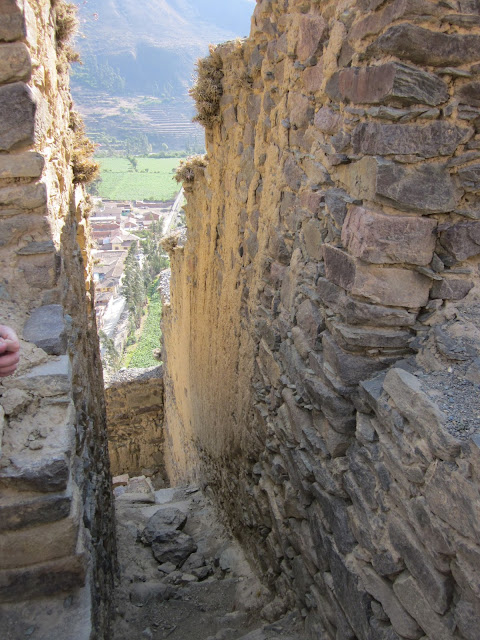Whenever we're planning vacations we seem to be inundated by offers and recommendations for guided tours. There isn't anything especially wrong with guided tours per se, but climbing out of the back of a minibus and being herded around with other English speakers - as is typical on many tours - is decidedly ungraceful and conspicuous.
When we were planning our trip to Peru S and I decided we wanted a different experience. No minibuses for this couple, not on this trip.
I don't even remember where I found Hacienda del Chalán (probably on another blog or TripAdvisor), but I am so glad that I did.
A tour of the Sacred Valley on horseback? Sign me up!
We booked a 1-day ride that would take us around the Sacred Valley and past the sites of Salinas, Maras, and Moray.
Our group consisted of our guide, S and I, and a mom and daughter from the Netherlands. The ride began by roughly following the Vilcanota River through the fields at the bottom of the valley. We crossed over the “Tarabamba” and “Paucarbamba” suspension bridges and it wasn't long before we started the climb to Salinas.
Another special aspect of this tour? We would get to ride Peruvian Paso horses - a special breed that isn't too common everywhere - and known for their smooth, four-beat gait.
After climbing steep and sunny hills we could see the blinding white of Salinas in front of us.
Our group was alone on our approach to Salinas. More and more of the terraces revealed themselves to us as we climbed the quiet hills.
We tied the horses at the top of the hill and walked down toward the pools.
As we made our way through the gift shop that you have to walk through to get up close to the salt ponds we were also met by groups of other tourists.
We were here in the off/shoulder season. It doesn't look that busy in these photos, but I had to wonder: how many people are pushed off the narrow path into the salty ponds during the crowded high season?
There are 3,000 pools owned by a collective of 300 families. The terraced pools are flooded with water from a spring in the hills. As the water evaporates the salt stays behind to be harvested by the families who own them.
These pools have been in use for hundreds of years and there are no signs of stopping.
We had lunch at a restaurant near the entrance to the salt ponds and then mounted up to continue our ride.
We had seen photos of Salinas and Moray before leaving on our trip. It was the riding through towns, villages, and the fields around Moray that surprised us with their beauty.
My photos don't do justice to the colors of the hills. I knew Peru was beautiful, but I couldn't stop looking at the hills and mountains as we rode through the quiet fields.
It was on this ride that I first noticed how gorgeous the sky in Peru was.
These are the kinds of things we would have missed if we had just signed up to be shuttled around in the back of a minibus.
We arrived at Moray and our group were some of the only visitors. Again we tied up the horses and explored on foot.
The exact purpose behind the terraced ruins is unknown.
The leading theory is that these concentric rings served as an agricultural laboratory. Plantings were made at the bottom of the pits and gradually moved up the terraces to observe how they handled the changes in altitude.
It was windy and chilly at the top of the terraces and warmer and still at the bottom. In fact, temperature can vary as much as 15*F from bottom terrace to the top.
As we explored further we noticed the same ingenious staircases in the terrace walls here at Moray that we had seen at Ollantaytambo.
Again, we were here in the off season and arrived later in the day so we had Moray mostly to ourselves and a few small clusters of other travelers.
We mounted our horses again and headed back down the valley toward Urumbamba where we had started.
This was an amazing experience that got us beyond the minibus, which was exactly what we wanted. Sometimes, I still daydream myself away from my desk at work back into the saddle in the mountains of Peru.
That being said, this is a full day tour designed for intermediate to advanced riders. This is not the right tour for you if your riding experience consists wholly of a one-hour trail ride you took that one time. The length can also be challenging physically.
I don't say these things to scare anyone off, but to hopefully help you see if this is right for you or not.
I hope this post inspires you to get off the bus and get out there in a different and unique way!
Tour details:
Our all-day tour cost us $95 each (in October 2015) and we added on extra for pick up/drop off at our hotel and a boxed lunch.
Website: http://www.haciendadelchalan.com/






























































